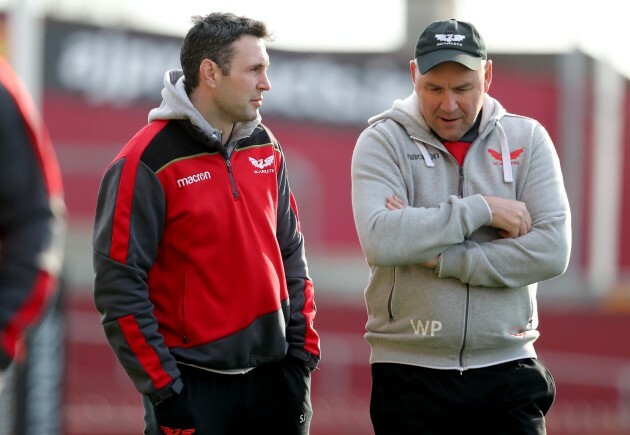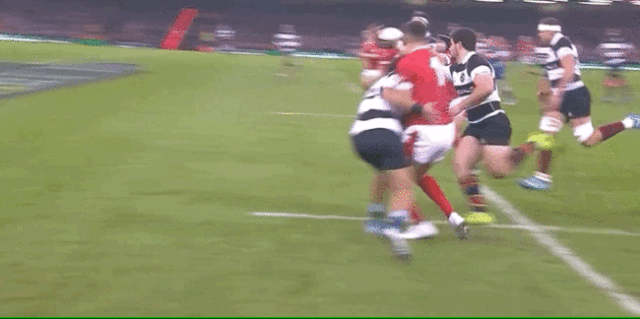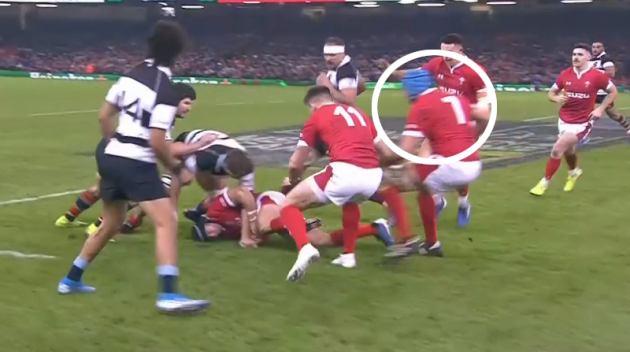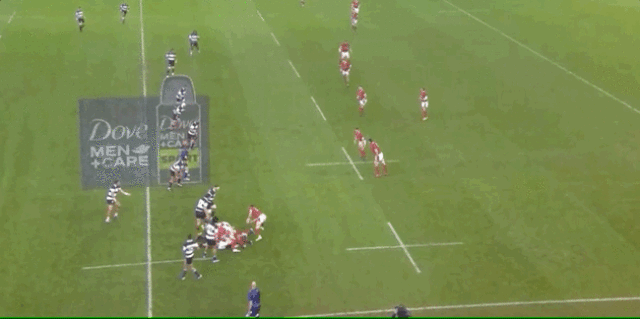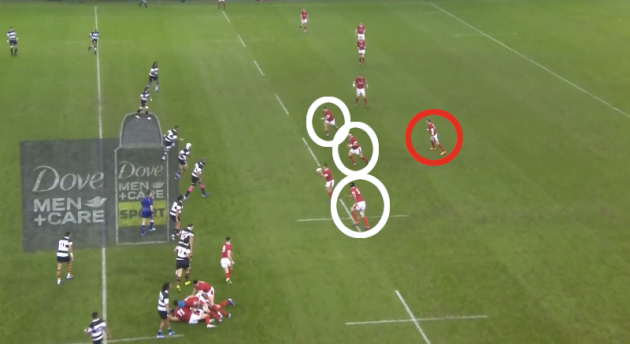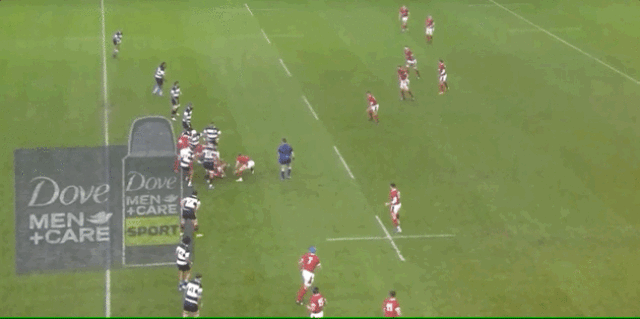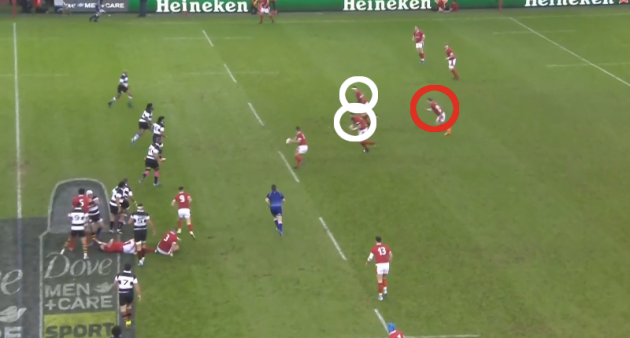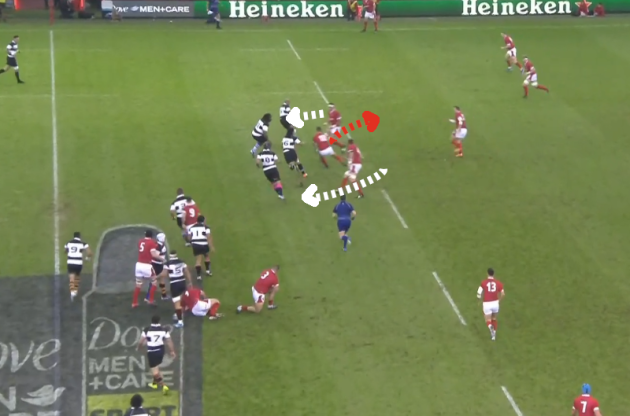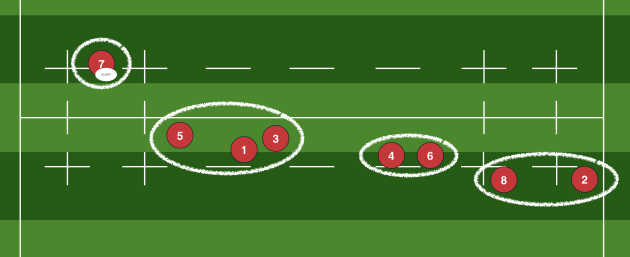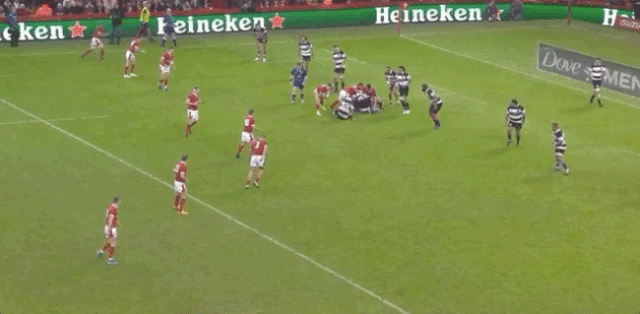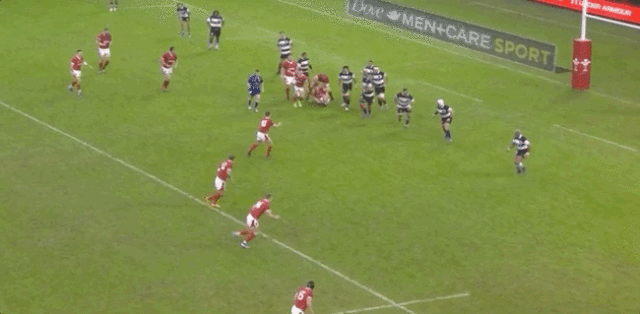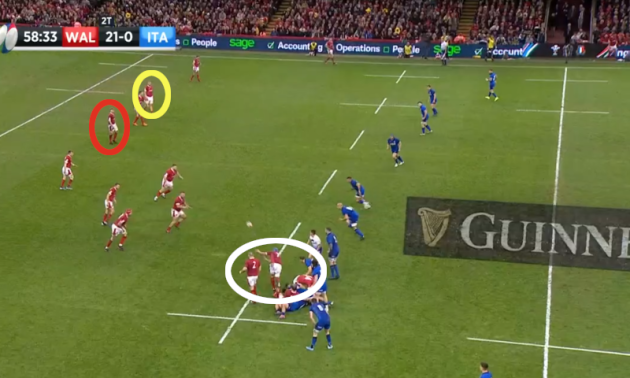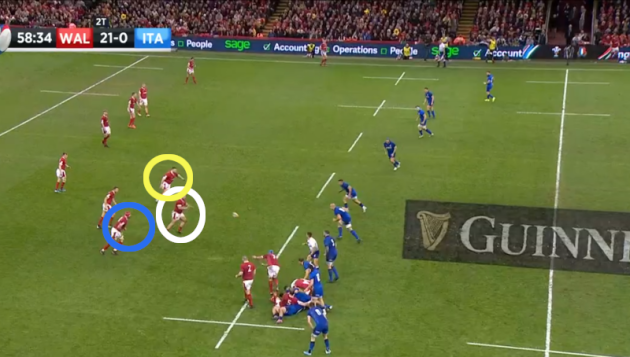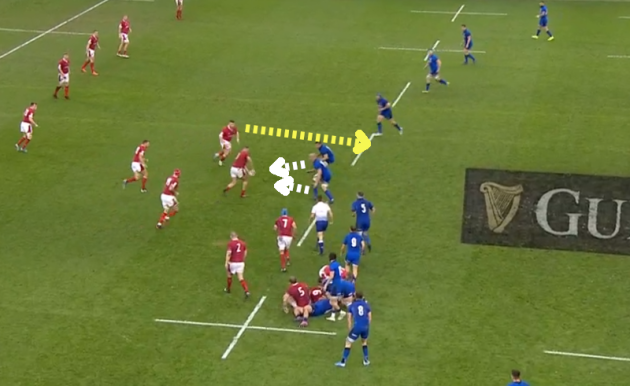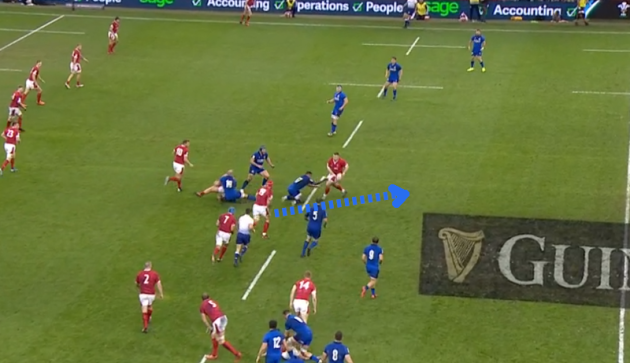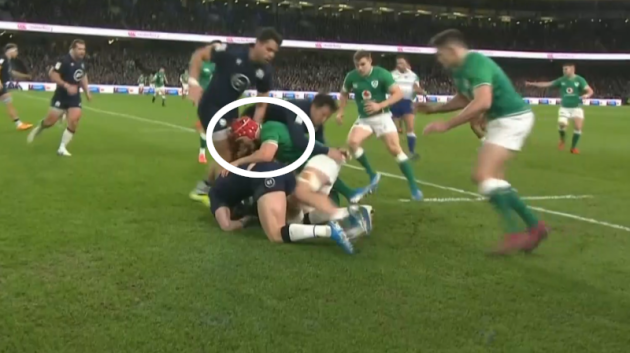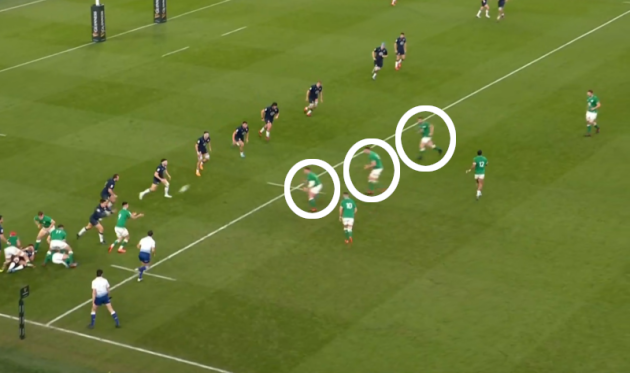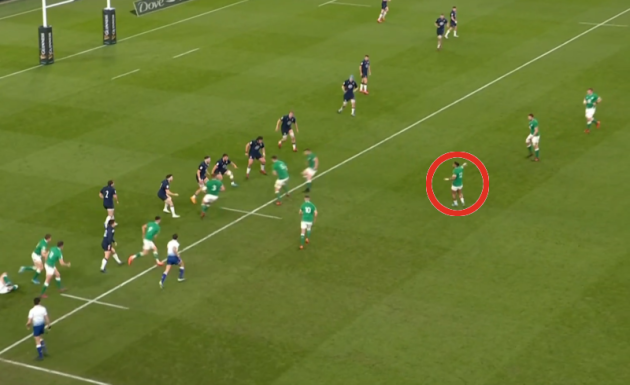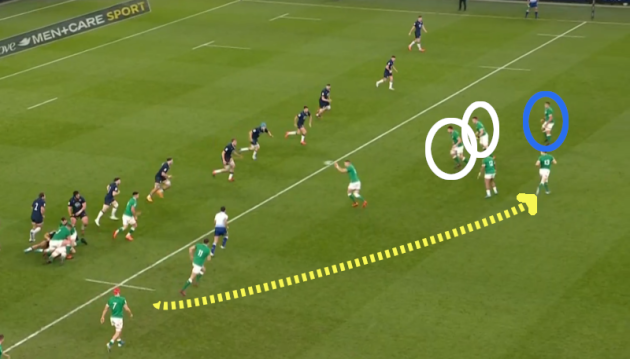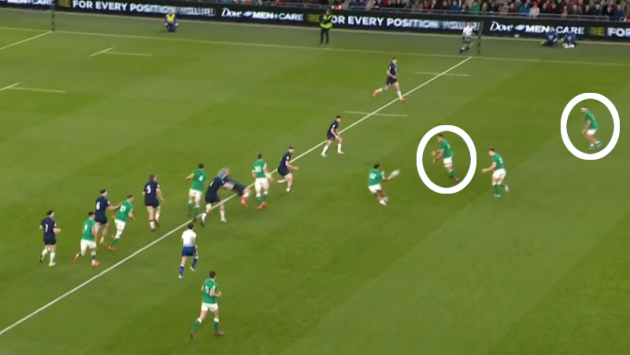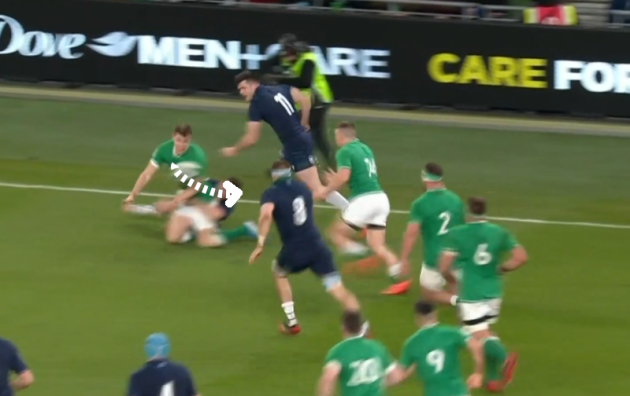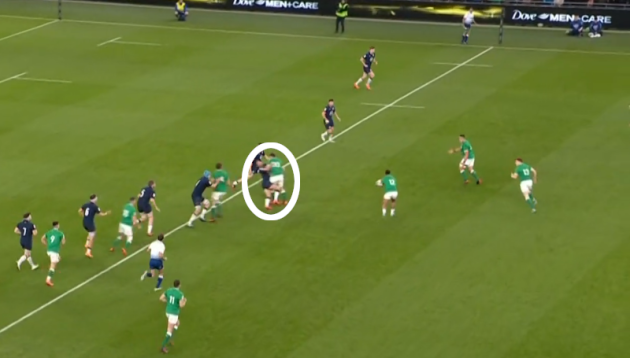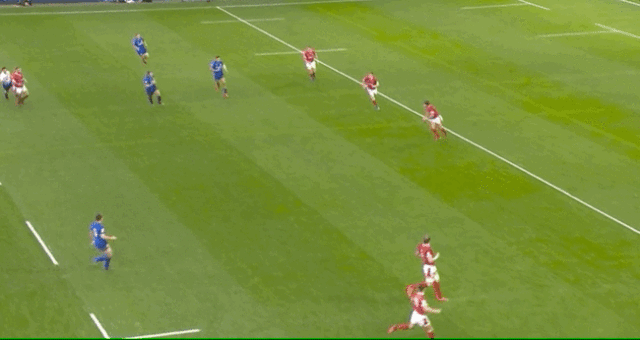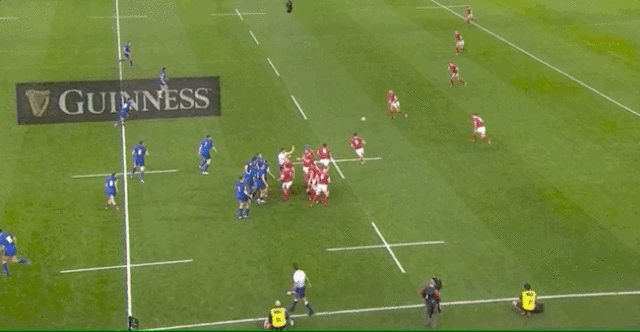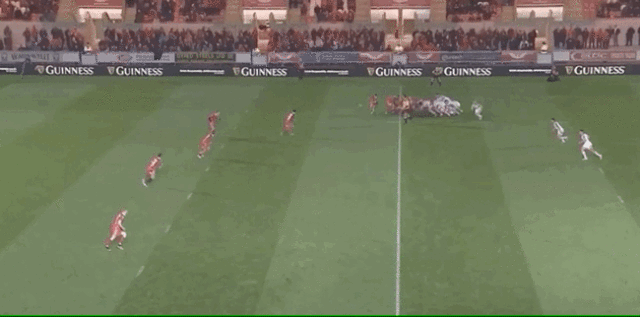WALES AND IRELAND have new head coaches in Wayne Pivac and Andy Farrell for this Six Nations and both are eager to develop their teams’ attacking games.
Before going on, it’s worth underlining that both new bosses have superb foundations to build on in terms of what Warren Gatland and Joe Schmidt left behind.
But with new attack coaches in Wales’ Stephen Jones and Ireland’s Mike Catt, the two sides appear keen to play with slightly more width when they are in possession.
That doesn’t necessarily mean they are aiming to fling the ball out into the 15-metre channels on every phase, but there does seem to be an intent from Wales and Ireland to possess a greater threat in those channels.
One way to achieve greater width in attack is through the team’s ‘shape,’ which usually refers to how the team’s forwards are positioned across the pitch.
We have seen in the past how Connacht have thrived using a 2-4-2 shape, winning the Pro14 in 2016 as teams struggled to deal with their attack.
In recent years, 1-3-3-1 has become the standard attacking framework in the game, with a huge number of teams employing it.
In last year’s World Cup, Japan excelled in a 1-3-2-2 shape that allowed them to consistently threaten defences. Ireland and Scotland struggled to deal with Japan’s attack, coached by the clever Tony Brown.
It’s worth stressing that the shape itself wasn’t what made Japan effective – it was more about their relentless energy, excellent skillsets, good decision-making, and physical ferocity. Their 1-3-2-2 shape was merely a framework to allow those things to thrive.
1-3-2-2 has become increasingly common in the game over the last two years, with the Welsh keen to pose a more consistent threat with their width, Pivac and Jones have installed it for Wales.
Funnily enough, Ireland also appear to be shifting towards a 1-3-2-2 shape in attack, even if they didn’t get fully firing against Scotland last weekend.
There were times when Ireland’s shape looked more like a 1-3-3-1 but it seems that Farrell and Catt are keen to get that extra forward slightly wider to make their team better-resourced in the 15-metre channel.
Wales have had two games under Pivac and Jones so far, having played the Barbarians in November, so we have double the amount of footage and plenty of good examples of them in their 1-3-2-2 shape, particularly given the disorganised nature of the opposition.
In the example below, Wales attack out of their 22 and up the left-hand side.
[Click here if you cannot view the clip above]
We can see that openside flanker Justin Tipuric commits into this ruck along with several of the Welsh backs.
Tipuric, circled above, is the ’1′ in Wales’ attacking shape here.
As scrum-half Tomos Williams moves the ball to the right, we see the next grouping of forwards used to carry off out-half Jarrod Evans.
[Click here if you cannot view the clip above]
Prop pair Wyn Jones and Dillon Lewis are set up outside Evans, while second row Adam Beard is just inside the out-half.
This trio of forwards [circled below] form the ’3′ in Wales’ shape.
We can see above that centre Hadleigh Parkes [circled in red] is set up just behind, offering Evans the possibility of pulling a pass back there if Wales want to attempt to get rapidly to the opposite side of the pitch.
However, Evans hits Lewis in this case, with Jones and Beard clearing out the ruck.
Williams shifts the ball right again as we see the first ’2′ grouping used as decoys by Evans.
[Click here if you cannot view the clip above]
Second row Jake Ball and blindside flanker Aaron Shingler form this ’2′ pod [circled in white below] outside Evans.
We can see that Parkes [red above] has again set up in behind the forwards and, this time, Evans wants to get the ball into the midfielder’s hands as Wales look to attack the edge.
Evans runs diagonally across the pitch to split the 2-man pod, with Ball dropping underneath him on a dummy switch line in a bid to hold the defence there, as we can see below.
Meanwhile, Shingler runs a straightening line outside Evans, offering him the possibility of a short, flat pass, again the idea being to fix the defenders. He even makes light contact with Mathieu Bastareaud in front of him.
But Evans pulls his pass behind Shingler to Parkes [red above], and we see the final ’2′ part of the Welsh shape.
[Click here if you cannot view the clip above]
As Parkes receives the ball and looks to fix Barbarians left wing Cornal Hendricks, we can see that Wales number eight Aaron Wainwright and hooker Ken Owens [circled in white below] are in the 15-metre channel, along with right wing Johnny McNicholl.
Owens has held the width right on the touchline throughout this passage, which stemmed from Wales gathering a Barbarians grubber kick down the left.
We can see the threat Wales now offer in the 15-metre channel as Wainwright, McNicholl, and Owens link out on the right.
Unfortunately for the Welsh, the offload from Owens back inside to McNicholl doesn’t go to hand but this passage gives us a clear example of what Wales are looking for with their 1-3-2-2 shape.
It’s worth pointing out that the roles in this shape are interchangeable depending on how Wales regain possession and which players are located where at that time.
That said, the props are generally not going to be in the wide channels in attack or defence so will generally be in between the 15-metre channels when Wales get into shape.
It was notable that flanker Shingler sent hooker Owens in for a try in the right corner in the second half against the Barbarians.
With Tipuric again in the left-hand side ruck, the pod of 3 [circled below] carry off Williams this time.
Evans then hits the first ’2′ pod, as we see below, with Lewis carrying off the out-half as Wainwright offers the inside option.
[Click here if you cannot view the clip above]
On the final phase of the attack, excellent handling from McNicholl – free to roam infield because two forwards are holding the width – allows Wales to get the ball into the 15-metre channel, where fullback Leigh Halfpenny and Wainwright tee up Owens’ score.
[Click here if you cannot view the clip above]
We saw several more example of Wales’ shape against the BaaBaas and also against Italy last weekend.
Rather remarkably, second row Alun Wyn Jones made just one carry in the Italy game but that was mainly because he usually ended up holding width as one of the forwards in the ’2′ in the wide 15-metre channel or was a decoy/cleaner in one of the other groupings.
Wales played out to the width several times against the Italians but the instance that will likely have pleased Pivac and Jones most was the lovely interplay from the ’3′ grouping just before debutant Nick Tompkins’ try.
In this example, Wales aren’t actually in 1-3-2-2 shape because they have just won a turnover.
They have three forwards around the ruck [white below], but there is still width to their attacking line as Wainwright [red] and sub back row Ross Moriarty [yellow] set up out to the left with several of the backs.
That threat of width – wing Josh Adams is hogging the left touchline – here is important, as we see the Italian defence spread out in response. This is a reaction to the picture in front of them, but also to Wales’ width throughout the game up until this point.
Spreading out leaves Italy less secure in the middle of the pitch and there is a ‘spacing’ issue immediately, with a clear gap in between the two Italian props.
Wales’ 3-man pod close to the ruck has organised itself swiftly and they take advantage of the Italian defence being spread out.
Tighthead prop Lewis [white below] in is the middle of the pod, with replacement lock Cory Hill [blue] on his inside and sub loosehead Rob Evans [yellow] to his outside.
Lewis receives the pass from the ludicrously talented Tipuric and runs diagonally at the defence, looking to lure in both Marco Lazzaroni and prop Danilo Fischetti, as indicated in white below.
With Evans [yellow above] running the short, flat line outside Lewis, the Wales tighthead knows that if he can sit Fischetti down, Lewis will be thundering into that clear gap in the Italy defence.
Lewis delays his pass superbly and though Fischetti does turn out to tackle Evans, the Wales loosehead easily wins the collision and gets beyond the attempted tackle into a position that leaves him free to offload back inside to the support-running Hill [blue below].
Hill gallops onto the ball and carries all the way beyond Italy’s 10-metre line, laying the platform for Wales to score on the next phase.
This kind of interplay is exactly what Pivac and Jones will be looking for from the Welsh forwards as they attempt to combine the threat of width with an ability to be effective closer to the ruck, as well as carry directly and aggressively when the defence is organised.
Ireland will need to be alert this weekend defensively, but they hope to bring their own threat with an increased width in their attack under Catt and Farrell.
The flow of last weekend’s game and Ireland’s lack of attacking set-piece platforms in the middle third of the pitch – as well as players getting used to new roles – meant Farrell’s men didn’t get into an ideal 1-3-2-2 shape very often.
Indeed, we misidentified their shape as a basic 1-3-3-1 with some variations on first review but, as highlighted by former Leinster and Scotland analyst Brett Igoe – who coaches with UCD and Leinster Schools – there was an example of Ireland getting into 1-3-2-2 in the first half.
Josh van der Flier made only three carries for Ireland in this game, a statistic which would be easy to criticise – like Jones’ for Wales – but his job was largely to hold width in Ireland’s attacking shape.
We see van der Flier [circled below] in the left-hand 15-metre channel in this instance, clearing out the ruck.
It’s also worth noting Garry Ringrose to the right of Ireland’s ruck as he will show huge work-rate to get to the other side of the pitch in this passage.
As Ireland play to their right, we see Ireland’s pod of 3 used to carry.
Tighthead prop Tadhg Furlong, second row James Ryan, and loosehead Cian Healy make up the three-man pod, with Ryan carrying off scrum-half Conor Murray’s pass.
As Ryan carries, we can see Bundee Aki [red below] organising for the next phase.
On that next phase, out-half Johnny Sexton steps up to play first receiver.
He has the ’2′ grouping outside him in Iain Henderson and Peter O’Mahony [circled in white below].
We can see that Aki has faded in behind those two forwards offering the pullback passing option for Sexton, while Ringrose has worked incredibly hard to get all the way across the pitch from the left-hand side [as indicated in yellow].
Interestingly, CJ Stander [blue above] initially steps up towards O’Mahony and Henderson as if to join them to form a 3-man pod.
That may indicate how Ireland are actually learning this new shape. Ireland sometimes operated with a 1-3-3-1 under Joe Schmidt, so Stander may initially feel he needs to support a carry here.
Instead, he backs away as Sexton screens a pass behind Henderson and O’Mahony to Aki.
As Aki looks to his outside, we can now see that final 2-man grouping in Ireland’s shape, made up of Stander and Rob Herring [circled in white below], the hooker having held width throughout this passage of turnover attack.
Aki plays a second screen pass behind Stander to Ringrose, who summons the energy to run a dummy switch with Herring, get outside Scotland’s Ali Price and then offload back inside to wing Andrew Conway.
Conway is just four metres short of the Scotland tryline, leaving Ireland in a very promising position, but play is called back for obstruction ahead of the ball by O’Mahony on Scottish out-half Adam Hastings as Sexton screened him to Aki.
It’s a glimpse of what Ireland are possibly looking to build towards.
Fluidity, understanding of roles, and communication will all likely improve as Ireland get more accustomed to the demands of their attacking shape.
Forwards obviously need to read what’s happening and appreciate where they need to set up. But the backs naturally have a huge role in directing and cajoling the forwards to be in shape, as well as being connected around that basic framework.
In that sense, the loss of Garry Ringrose is a big one for Ireland.
Most vitally, Ireland’s decision-making and skill levels need to be exemplary. The attacking framework is exactly that, a framework in which their physical, technical, and decision-making skills must thrive.
Farrell and Catt will, one imagines, continue to remind their players of the primary importance of making good carries, clearing out rucks effectively, being intelligent in their decision-making, and also scanning for backfield space for their kicking game.
There are further similarities between the journeys Wales and Ireland are on in how they both appear more willing to search for space kick return.
Ireland’s previous tactic was generally for their fullback to sprint straight upfield in a bid to meet the retreating forwards and set up a secure ruck, while Wales often did similar or kicked back.
As we discussed on Monday, new first-choice fullback Jordan Larmour showed hints of this for Ireland, even if the execution and decision-making weren’t always ideal.
With Italy handing them kick return possession with an extremely poor kicking game last weekend, Wales also showed their intent in this area.
[Click here if you cannot view the clip above]
We get an example of the Welsh mindset in the clip above, as fullback Halfpenny chips ahead on kick return – reminiscent of Larmour doing the same for Ireland against the Scots.
Scrum-half Williams regathers the ball in behind but play is brought back for the trip on Halfpenny after he has kicked ahead. Wales kick the penalty for a 9-0 lead and their attacking mindset is rewarded.
There were several other good examples from Wales last weekend, with one kick return leading to a disallowed try, but it’s worth stressing again that Italy’s kicking was very poor and their kick-chase was often disorganised.
Wales did some sharp stuff on set-piece attack last weekend but, again, the Italians’ poor defence must be considered here, particularly for Josh Adams’ opening try.
Unsurprisingly, we also saw some of the old Scarlets playbook, with Pivac and Jones having joined Wales from the Llanelli-based region.
[Click here if you cannot view the clip above]
Wales actually get a scrum free-kick above but run the play they had initially called off the scrum, with Parkes taking a switch off Biggar before screening outside centre George North back to Biggar.
It’s an eye-catching play that Scarlets used last season under Pivac and Jones, and it’s just one example of their inventive streak with set-piece attack.
As Ireland have studied the Pivac-Jones playbook in recent weeks, they will also have noted how most of the plays have multiple options.
In this case, we have seen Scarlets use the front-door option of their outside centre to excellent effect in the past.
[Click here if you cannot view the clip above]
So while Wales might not use this specific play again this weekend, Ireland will need to be mindful of multiple options on each set-piece move.
Unfortunately, we didn’t get to see any of Ireland’s set-piece plays last weekend against Scotland.
They didn’t have a single attacking scrum in the game. Ireland had 10 lineouts but six of those came either inside or just outside the 22, where they attempted to maul without success.
In the opening minutes and again towards the end of the game, Ireland box-kicked from lineouts in the middle third of the pitch in a bid to pressurise Scotland, very nearly winning the second of those efforts back only for an unlucky knock-on.
Ireland did set up for a set-piece strike once in the first half, using a four-man lineout and Tadhg Furlong in midfield – a set-up we have seen before – but we didn’t get to see their plan unfold as they failed to win the lineout, their only miss in that area last weekend.
It seems that both of these teams are at the start of similar journeys with their under new head coaches and new attack coaches.
It will be fascinating to see what part their targeted developments play in this weekend’s contest and whether both teams continue to push their aims for more width and kick-returning ambition in their games.
The truth is that the physicality, defences, kicking games, and refereeing will play central roles too, and quite likely be even more important.
But we await to see whether Wales and Ireland can continue their aims for development with so much on the line this weekend.
